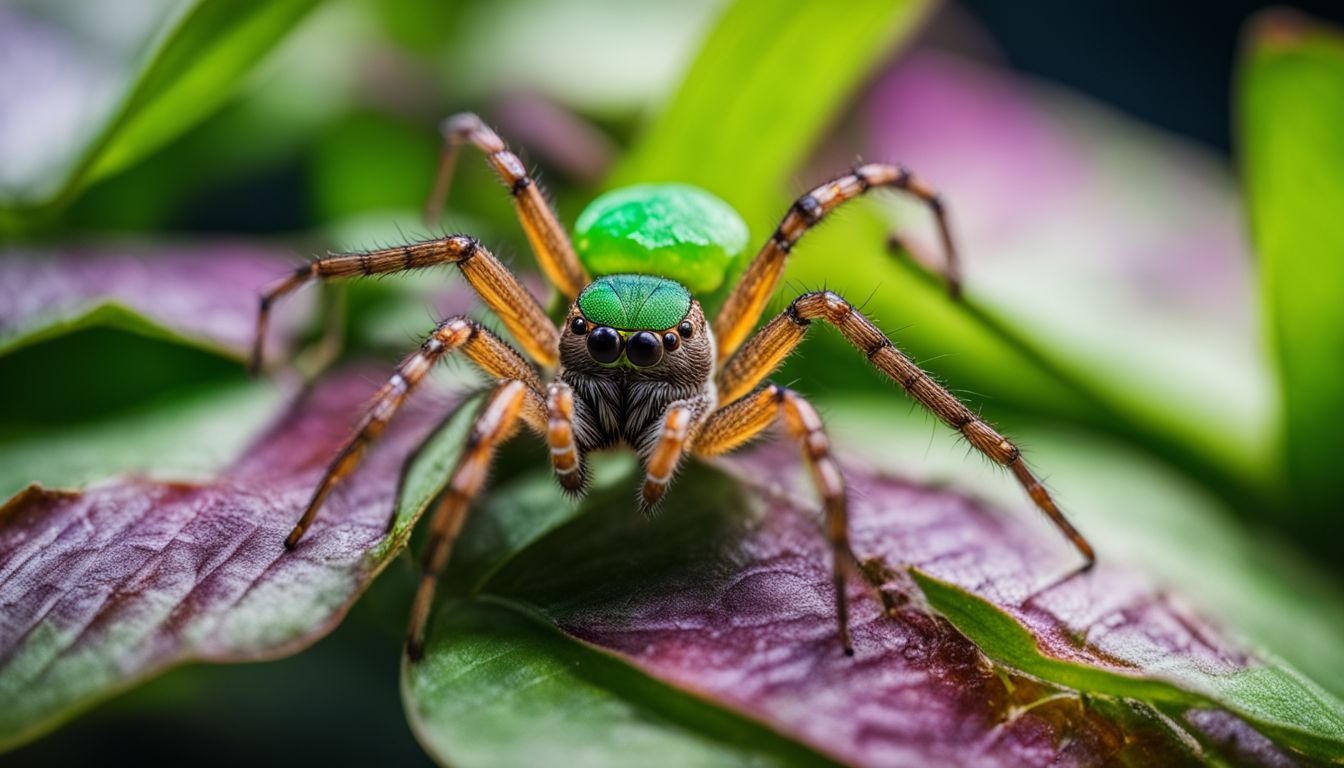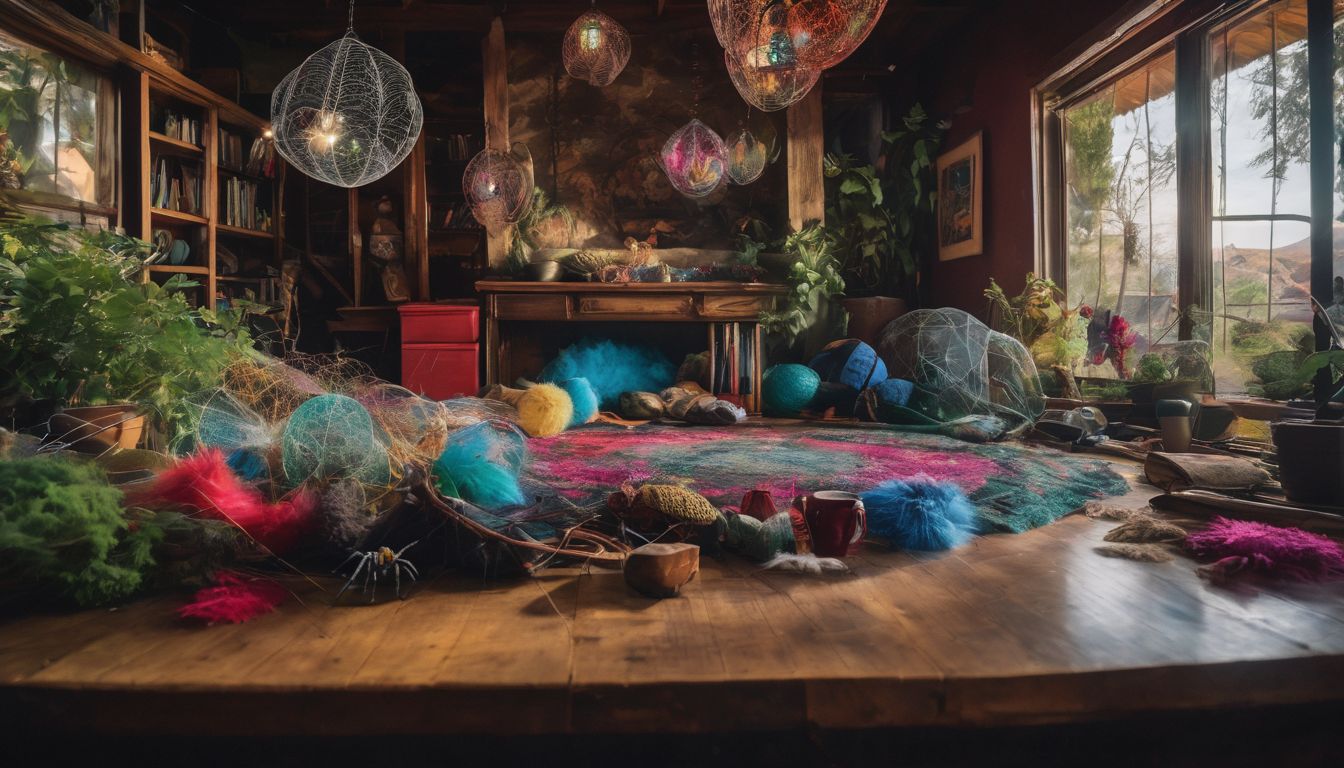Have you ever noticed more spiders in certain parts of your house and wondered why? Interestingly, studies like the one from the University of Cincinnati show that spiders have color preferences, a fact that might surprise many.
This article will guide you through which colors attract these eight-legged creatures and how to use this knowledge for spider control at home. Discover what hues can keep spiders away!
Key Takeaways
- Spiders have color preferences, with green and ultraviolet light being their top choices. They are attracted to these colors more than others.
- Understanding spider vision is crucial for effective spider control at home. Spiders see a wide range of hues that humans cannot perceive, and their color preferences can guide homeowners in deterring them effectively.
- Homeowners can use specific colors to repel spiders: light blue and yellow are unattractive to spiders, while earth tones like beige, brown, and tan are less appealing. Utilizing these colors strategically can help discourage spiders from nesting in or around homes.
Understanding Spider Vision

Spiders perceive color differently than humans do, with most species having dichromatic vision. This means they are sensitive to green and ultraviolet light, which affects their color preferences.
Understanding how spiders see the world can help us better understand their behavior and how to control them in our homes.
How Spiders Perceive Color
Jumping spiders see the world differently than we do. They have three color channels, which means they can spot more colors than humans can. Their eyes are good at seeing green wavelengths and even ultraviolet light, which is invisible to us.
Some jumping spiders have a special trick up their sleeve. They use a filter to notice reds and oranges that usually would be hidden from them. This helps them during mating because peacock jumping spiders need to see each other’s bright colors for their dances to work well.
The Visible Spectrum for Spiders
Spiders see the world differently than we do, especially when it comes to color. Their eyes are tuned to detect a wide range of hues that can be outside human sight. Some jumping spiders have three color channels in their vision.
This tri-color ability lets them see from ultraviolet (UV) all the way into some reds. They use this skill to find mates or hunt down prey.
The filters in spider eyes help them pick up red and orange colors too. This means they can perceive things on the spectrum that humans cannot see without help. Because these tiny hunters rely on colorful signals in nature, understanding what part of the spectrum they can see is key for learning about how they live and behave.
Colors That Attract Spiders

The allure of green and ultraviolet light are two colors that attract spiders. Understanding these color preferences can help homeowners make informed decisions when it comes to spider control strategies.
The Allure of Green
Green catches a spider’s eye. Wolf spiders, for example, can spot this color really well. Because their eyes work best with green and ultraviolet light, places that are green seem perfect to them.
In fact, studies show that these spiders will go towards green things more than any other color.
If you’re worried about spiders coming too close, be careful with how much green is around your home. Flowers or garden plants with lots of greens could be like a welcome sign for them! Now think about another thing spiders find hard to resist: the invisible pull of ultraviolet light.
Ultraviolet: An Invisible Attraction
Spiders are really drawn to ultraviolet light, more than any other color. This is because many spiders can see ultraviolet light and use it to attract their prey. For example, wolf spiders have eyes that can only see ultraviolet and green colors due to their vision abilities.
So, by using special silks that reflect ultraviolet light in their webs, they make them even more appealing to insects.
This ability helps these arachnids catch the bugs they need for food because many insects are naturally attracted to UV light.
Colors Spiders Dislike
Light Blue: An Unwelcoming Hue – While spiders are color-blind and have limited perception of certain colors, studies have shown that they tend to avoid light blue hues. Understanding their aversion to specific colors can be helpful in deterring spiders from certain areas.
Light Blue: An Unwelcoming Hue
Spiders really don’t like the color light blue. It’s a big turn-off for them. This is because it makes them feel exposed and vulnerable to predators, so they tend to stay away from this color.
If you want to keep spiders at bay, avoiding light blue in your surroundings could be a good move. An easy way could be to bear this in mind when choosing colors for your porch or outdoor areas.
The Limitations of Spider Color Perception
Spiders have a limited ability to see colors. Most of them, except for some like the wolf spider, are almost colorblind. Their vision is based on detecting movement and contrast rather than precise colors.
This means that they can’t see the full range of colors like humans do.
Wolf spiders, however, are an exception. They can detect green and ultraviolet light but cannot perceive most other colors. Despite this limitation in their color perception, spiders make up for it through their sensitive hairs that help them feel vibrations and navigate their environment effectively.
Practical Tips for Homeowners
Choose colors that spiders are less attracted to, such as light blue or white, when painting your home. Utilize natural spider deterrents like peppermint oil to keep arachnids at bay.
Color Choices to Deter Spiders
Spiders are repelled by the color light blue, making it an effective choice for deterring them. Additionally, yellow is a color that spiders dislike, so avoiding this hue can help keep them away. Here are some color choices to deter spiders:
- Use earth tones like beige, brown, and tan as these colors are less attractive to spiders due to their resemblance to natural habitats.
- Opt for white or pastel shades for walls and furniture as they are less likely to attract spiders compared to darker colors.
- Utilizing Color in Spider Control Strategies
Utilizing Color in Spider Control Strategies
Color choices play a crucial role in deterring spiders from homes. To effectively control spiders, consider the following strategies:
- Use light blue or yellow lighting around your home to repel spiders as they dislike these colors.
- Opt for green and ultraviolet lighting outdoors to attract insects away from your house, reducing spider food sources.
- Apply light blue or yellow paint on the exterior of your home to discourage spiders from nesting in these areas.
- Consider planting greenery around your property to draw insects away from the house, diminishing the spider’s food supply.
Additional Insights: A Look at Bog Spiders
Bog spiders prefer darker and more muted colors in their environment.
These species are known to blend in with the natural surroundings, including marshes and wetlands.
Their color preferences help them hide from predators and hunt for prey effectively.
Conclusion
In conclusion, spiders have color preferences, with green being their favorite. They can see more colors than humans and may be attracted to specific hues. Understanding spider color vision can help homeowners deter them effectively.
This study sheds light on the intriguing world of arachnid color preferences.
For more fascinating insights on these unique creatures, don’t miss our feature on bog spiders.
FAQs
1. Can spiders really see different colors?
Yes, spiders have a special kind of vision called trichromatic vision that lets them see some colors using their photoreceptors in their eyes.
2. Do all spiders react to colors the same way?
No, male and female spiders may like different colors due to the way they behave and their compound eyes work differently.
3. Why do some people think darkness attracts more spiders?
George Uetz, who studies spider behavior, found that some people believe darkness draws in spiders because these creatures often hunt at night when it is dark.
4. How are spider eyes different from human eyes?
Spider eyes have structures named ocelli which are simple compared to human retinal cells; humans usually can see better than most spiders because of our complex human eyesight.
5. Does knowing about spider color preferences help with pest control?
Understanding what colors attract or don’t attract spiders can help people avoid bringing these pests into places by accident.




